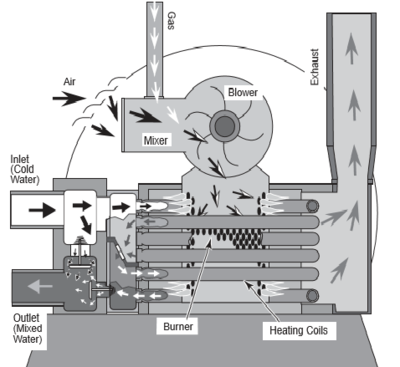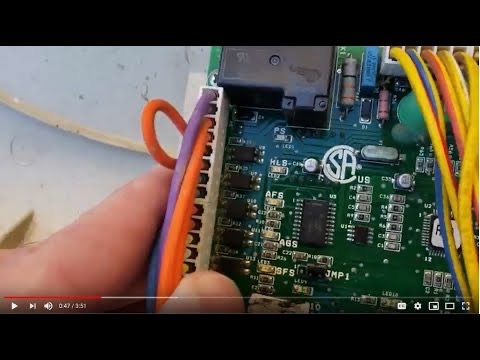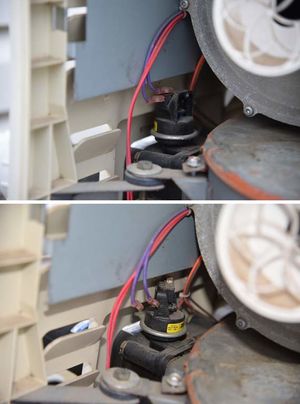Pentair MasterTemp Heaters
The MasterTemp heater is a compact, lightweight, efficient, induced-draft, gas fired high performance pool and spa heater that can be directly connected to schedule 40 PVC pipe. The MasterTemp heater also comes equipped with the Pentair multifunction temperature controller which shows, at a glance, the proper functioning of the heater. All MasterTemp heaters are designed with a direct ignition device, HSI (hot-surface ignition), which eliminates the need for a standing pilot. The MasterTemp heater requires an external power source (120/240 VAC 60 Hz) to operate.[1]
Heater Description
Precisely matched orifice plates meter the air and gas into the mixer. The blower draws the air and gas through the mixer and forces it into the burner’s flame holder. A sealed heat exchanger surrounds the flame holder, discharging exhaust gases out the flue.
Two inch PVC water piping connects directly to the manifold/header on the heat exchanger using 2" PVC slip unions provided with the heater. The outer manifold remains cool; no heat sinks are required. A thermal regulator and an internal bypass regulate the water flow through the heat exchanger to maintain the correct outlet temperature. The heater operator control panel board assembly is located on top of the heater.
Sequence of Operation
An electronic temperature sensing thermistor in the manifold adapter inlet controls the heater operation. When the inlet water temperature drops below the temperature set on the operating control, the burner controller supplies power to the combustion air blower through a series of safety interlocks. The interlocks consist of:
- the pressure switch (PS), which senses that the pump is running,
- the high limit switch (HLS), which opens if the heat exchanger outlet temperature goes above 135° F (57° C), and
- the air flow switch (AFS), which senses the pressure drop across the air metering orifice,
- the automatic gas shut-off (AGS) switch, which opens if the heat exchanger outlet temperature goes above 140° F (60° C).
- the stack flue sensor (SFS), which shuts down the heater if the flue gas temperature reaches 480° F (249° C).
The air flow switch (AFS) senses the pressure drop across the air metering orifice. As soon as there is sufficient air flow,the AFS closes, closing the circuit to the hot surface igniter (HSI), which ignites the fuel mixture. On a call for heat, the blower and HSI are energized. In about 20 seconds, the gas valve opens and ignition occurs. The HSI then switches to asensing mode and monitors the flame.
The heater is equipped with a digital operating control that enables the user to pre-set the desired pool and spa water temperatures. The control enables the user to select between pool and spa heating, and features a digital display thatindicates the water temperature.
Installation
Heater Bypass
A manual heater bypass allows the heater to be taken out of the water loop for maintenance or if there are concerns about the water quality such as low pH that can damage the heat exchanger.
Pentair recommends a manual bypass when the water flow rate exceeds the maximum 120 GPM. After installing the valve, adjust the valve to bring the flow rate within the acceptable range. Then remove the valve handle or lock it in place to avoid tampering. See page 13 of the Installation Manual
Heater Cooldown
The filter pump should run continuously when the heater is on, and for at least 5 minutes after the heater turns off. Any switches in the pump circuit (including circuit breakers) that can disconnect the pump must also disconnect the heater. See page 29 of the Installation Manual
A time clock controlling the filter pump should have a low-voltage Fireman’s Switch that switches off the heater at least 15 minutes before shutting off the pump.
Firemans Switch
The "Fireman's Switch" is a poor name for the 2 wire 24 volt remote control system of the heater. The Fireman's Switch is a 2 wire control that can connect to automation such as the EasyTouch or IntelliCenter or to a timer.
RS-485 Remote Control
The MasterTemp can connect to Pentair control systems via a 3 wire RS-485 connection. See page 30 of the Installation Manual
What Do the Diagnostic LEDs Mean on the Pentair MasterTemp?
Diagnostic LEDs are on the back of the Pentair MasterTemp heater board.[2]
The following are the LEDs:
- .....PS (Pressure Switch)
- .....HLS (High Limit Switch)
- .....SFS (Stack Flue Sensor)
- .....AFS (Air Flow Switch)
- .....AGS (Automatic Gas Shutoff).
- .....Service System
- .....Thermistor
- .....Heating
- .....Pool On
- ...Spa On
- ...Service Heater.
HLS (High Limit Switch) Error
The HLS is often caused by lack of sufficient water flow through the heat exchanger. This can be due to several things:
- Thermal regulator not opening.
- External bypass open.
- Internal bypass broken.
- Pump too small or on too low rpm.
- Clogged filter.
- Scale in heat exchanger.
Start by checking the thermal regulator.
E05/E06/SFS (Stack Flue Sensor) Error
E05 errors are due to things like a sooted exchanger(fuel delivery, venting), scaled up exchanger (water side), or a low water flow.[3]
E05 and E06 are more or less the same thing. Problem with the Stack Flue Sensor.[4]
You can get an E05(open sensor) if a rat chews through the wire(s). An E06 is a shorted sensor, or if the board thinks it is a switch, and not a thermistor (didn't get programmed when it was installed).
Turn the heater on. The fan will come on for about 30 seconds, then you will hear a click, and the heater should fire. At that moment, which ever thermostat you are using (POOL or SPA) hold that button down for ~10 seconds. Display should change from water temp to exhaust temp. Normal temps should be in the range of 290-350. 350-500 is considered high and you should look for:[5]
- Sooted exchanger(external) due to improper gas pressure or lack of proper venting. either supply of fresh air or exhaust, or both. Heater is being starved of air and the resulting air/fuel mix is too rich (fat).
- Calcified exchanger (internal) due to improper water chemistry. Note: Not necessarily right now, but at some point in the past, and for a while. This does not happen overnight.
- Flow or velocity issue. Water is moving too slowly through the exchanger, gathering or absorbing too much heat, and is not carrying it away quickly enough to keep the heater at a workable temp. In this case, you may have a valve closed down, but not fully closed, or may be wanting to save a little more money on your electricity bill, so you turned down your VS pump as low as you can get away with. You will need to turn it back up to correct this !
Check the interior for obstructed venting (intake and exhaust). Animal nests, spiders, mud dauber nests against the air blower vent, can all block the air flow and lead to an overheat and SFS error.
You see those problems a lot more then a sensor that has gone bad. Although continued high temps could eventually cause a SFS to fail. The SFS will let the heater stack temp to run up to 480 degrees before it will shut the heater down. In the case of a sooted exchanger, the stack flue temp would rise slowly over time (weeks/ months) subjecting the sensor to extended over temp conditions.
The sensor may be tested with an ohm meter (3.8 MegOhms @ 77F) If you decide to get a new SFS, check the stack flue temp when you get it back together and running to confirm that the stack flue temps are where they should be, and not too high.
The part number for the Stack Flue Sensor is Pentair 42002-0024S
If you hold down POOL or SPA button for at least 10 seconds it displays the exhaust temp. Normal temps should be ~290-350.
AGS Error
- Remove the leads from the AGS sensor and connect them together. Temp only for the test.
- Then, check the continuity of the sensor. It should be closed.
- Start the heater. If the sensor opens, immediately turn off the heater.
- If the sensor opens, it might be a bad sensor or the water is overheating.
- To test the sensor, put it in hot water to see where it actually opens.
- If the sensor does not open and the heater shuts off with an AGS light, the board is bad.
Refer to to pages 31 and 32 of the Installation Manual[6] the connection and ladder diagrams. You will notice that all of the safeties and gas valve are run through the operating control and ignition module.
You should first have 24 volts ungrounded to IND on the ignition module through water pressure switch and hi limit to start the inducer (blower) motor which will then make the air flow switch to put 24 volts ungrounded to the TH (W on some) terminal on the ignition module. This should start the ignition trial.[7]
After the igniter warm up time the ignition module powers the gas valve through VAL on the ignition module, but this also goes through the operating control VAL which then goes through the AGS safety to the gas valve. This is your ignition module Fenwal 35-662944-013 and it is user specifically modified which is why you don't see a W terminal.
You should notice on the ladder diagram that one leg of the 24 volt side is grounded. Right after the heater fires up, if you add a jumper from the ignition module VAL terminal to the TH terminal on the gas valve and the heater keeps firing then the problem is either with the AGS switch or the operating control. If it still shuts down then the problem is with flame sensing.
Repairs
Parts diagrams including replacement part numbers are at:
MASTERTEMP HEATER BURNER SYSTEM REPLACEMENT PARTS
MASTERTEMP HEATER ELECTRICAL SYSTEM REPLACEMENT PARTS
MASTERTEMP HEATER WATER SYSTEM REPLACEMENT PARTS
Thermal Regulator
The thermal regulator is behind a screw off cap between the in/out pipes in the heaters header. With the pump off, unscrew the cap and pull the regulator out. Note, if the regulator does not come out easily and feels like it hung up on something, then the bypass is broken and hanging in the way. If it comes out with no issues I'm sure you find it's all gunked up. Then use you fingers and stick them in the opening and feel up around towards the top middle and you should feel a round button like item, that's the bypass. If you feel it and it seems to be solid, then you are good with that.[8]
To test the thermal regulator Put it in hot water (130 to 140 F) to see if it opens.
The thermal regulator is sensitive to water chemistry and can get erosion.
Bypass Valve
If the byass valve is broken the heater will short cycle and make noise. If you look in the hole where the thermal regulator goes, you should be able to see the black disk. If you look in the water inlet, you should be able to see the spring.
You will have to take the manifold off to replace the Internal by-pass kit P/N 77707-0001.
Guide to replacing the bypass valve
Bad Temperature Sensor
- Problem - Heat will not fire, blower does not even turn... heat is set at 89*. membrane is showing water temp 107... easy touch panel temp reading is accurate (thermometer in pool 83*).[9]
Blower not Operating
Listen closely when you turn the heater on, after it cycles through the 888, 128, R13. You may need to put your ear right next to the top of the heater (where the board is) to hear if the small relay on the board clicks (May sound more like a "tick" than a "click"), giving voltage to the blower. This click will be more subtle than the click you normally hear when the gas valve opens (you wont hear that one though if the blower never starts).[10]
If you can hear the click, look at the blower. No click, look at the board. If you are getting the AFS error, that means the safety switches have been satisfied, and the board should be telling the blower to start (power to relay coil).
Main Board
Control Board Kit (NA, LP Series) part number is 42002-0007S.
Pentair Membrane Key Pad Replacement
The membrane keypad sometimes fails and is separately replaceable with Pentair part number 472610Z.
Winterizing
Removing Water Pressure Switch
One of the winterizing steps in the manual is to remove the water pressure switch.[11]
Gain access to the heater by removing the two panels and locate the water pressure switch. Disconnect the two electrical leads and rotate the switch counterclockwise.
You may find the switch terminals hit the frame hits is the main body panel of the heater. You have to remove the side panel as well. The panel does come off.
Air Intake
Seal up the air intake with some plastic while in there.
Tips
- After start-up, the outlet water pipe should feel slightly warmer than the inlet pipe. If it feels hot, or if you hear the water in the heater boiling, there may not be enough water flow to the appliance. Make sure that the filter is not plugged. If water temperature remains high but the unit continues to operate, turn off the appliance and call your service technician.
- Operating this heater continuously at water temperatures below 68° F. (20° C) will cause harmful condensation and will damage the heater and void the warranty.
- When starting the heater for the swimming season with a water temperature below 50° F (10° C), the heater may be used to heat the water; however, make sure that the heater operates continuously until the water temperature reaches the heater’s minimum setting of 68° F (20° C).
- During cold weather, if there is no danger of freezing, operate the filter pump continuously even if the heater is not operating. If air temperatures are expected to drop below freezing (32° F/0° C), shut down the heater and winterize it.
.
- ↑ https://www.pentair.com/content/dam/extranet/product-related/product-manuals/pool-and-spa-equipment/mastertemp/MasterTemp_Pool_and_Spa_Heater_Installation_and_Users_Guide_English.pdf
- ↑ https://www.troublefreepool.com/threads/mastertemp-400-shutdown-issue-e05-error.193404/post-1704484
- ↑ https://www.troublefreepool.com/threads/pentair-mastertemp-400-error-code-e05.73905/post-1191649
- ↑ https://www.troublefreepool.com/threads/mastertemp-400-e05-error.171793/post-1517990
- ↑ https://www.troublefreepool.com/threads/mastertemp-400-e05-error.171793/post-1514855
- ↑ http://www.pentairpoolme.com/uploads/document/file/554/Manual_MasterTemp.pdf
- ↑ https://www.troublefreepool.com/threads/another-mastertemp-400-with-ags-led-service-heater-led.196702/post-1734928
- ↑ https://www.troublefreepool.com/threads/pentair-master-temp-400-problems.113128/post-1001404
- ↑ https://www.troublefreepool.com/threads/mastertemp-400-ng-bad-board.192416/
- ↑ https://www.troublefreepool.com/threads/mastertemp-400-issue.151028/post-1341812
- ↑ https://www.troublefreepool.com/threads/water-pressure-switch-removal-pentair-heater.153252/post-1355449






